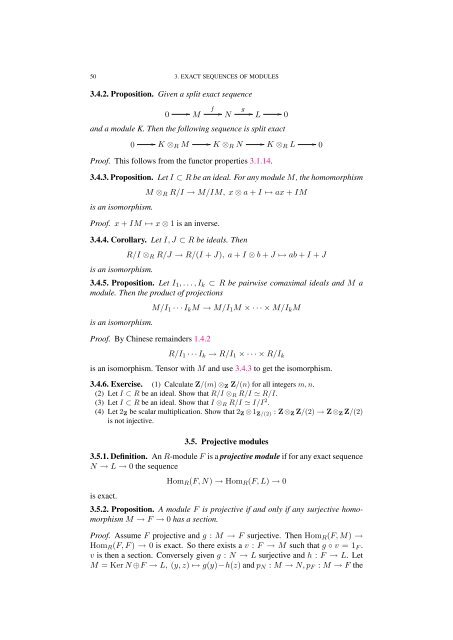Commutative algebra - Department of Mathematical Sciences - old ...
Commutative algebra - Department of Mathematical Sciences - old ...
Commutative algebra - Department of Mathematical Sciences - old ...
Create successful ePaper yourself
Turn your PDF publications into a flip-book with our unique Google optimized e-Paper software.
50 3. EXACT SEQUENCES OF MODULES<br />
3.4.2. Proposition. Given a split exact sequence<br />
0<br />
f<br />
<br />
M<br />
g<br />
<br />
N<br />
<br />
L<br />
and a module K. Then the following sequence is split exact<br />
0<br />
<br />
K ⊗R M<br />
<br />
K ⊗R N<br />
Pro<strong>of</strong>. This follows from the functor properties 3.1.14.<br />
<br />
0<br />
<br />
K ⊗R L<br />
3.4.3. Proposition. Let I ⊂ R be an ideal. For any module M, the homomorphism<br />
is an isomorphism.<br />
M ⊗R R/I → M/IM, x ⊗ a + I ↦→ ax + IM<br />
Pro<strong>of</strong>. x + IM ↦→ x ⊗ 1 is an inverse.<br />
3.4.4. Corollary. Let I, J ⊂ R be ideals. Then<br />
is an isomorphism.<br />
R/I ⊗R R/J → R/(I + J), a + I ⊗ b + J ↦→ ab + I + J<br />
3.4.5. Proposition. Let I1, . . . , Ik ⊂ R be pairwise comaximal ideals and M a<br />
module. Then the product <strong>of</strong> projections<br />
is an isomorphism.<br />
Pro<strong>of</strong>. By Chinese remainders 1.4.2<br />
M/I1 · · · IkM → M/I1M × · · · × M/IkM<br />
R/I1 · · · Ik → R/I1 × · · · × R/Ik<br />
is an isomorphism. Tensor with M and use 3.4.3 to get the isomorphism.<br />
3.4.6. Exercise. (1) Calculate Z/(m) ⊗Z Z/(n) for all integers m, n.<br />
(2) Let I ⊂ R be an ideal. Show that R/I ⊗R R/I R/I.<br />
(3) Let I ⊂ R be an ideal. Show that I ⊗R R/I I/I 2 .<br />
(4) Let 2Z be scalar multiplication. Show that 2Z ⊗ 1 Z/(2) : Z ⊗Z Z/(2) → Z ⊗Z Z/(2)<br />
is not injective.<br />
3.5. Projective modules<br />
3.5.1. Definition. An R-module F is a projective module if for any exact sequence<br />
N → L → 0 the sequence<br />
is exact.<br />
HomR(F, N) → HomR(F, L) → 0<br />
3.5.2. Proposition. A module F is projective if and only if any surjective homomorphism<br />
M → F → 0 has a section.<br />
Pro<strong>of</strong>. Assume F projective and g : M → F surjective. Then HomR(F, M) →<br />
HomR(F, F ) → 0 is exact. So there exists a v : F → M such that g ◦ v = 1F .<br />
v is then a section. Conversely given g : N → L surjective and h : F → L. Let<br />
M = Ker N ⊕F → L, (y, z) ↦→ g(y)−h(z) and pN : M → N, pF : M → F the<br />
<br />
0
















